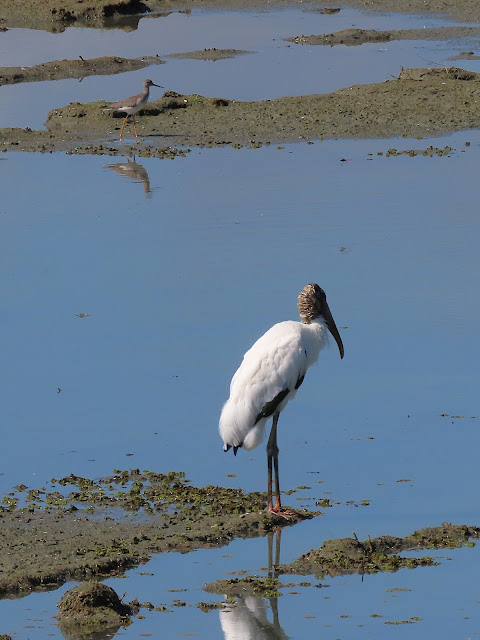11 January, 2025
Las Cruces - Rice Fields at Las Pangas- Selva Mar Hotel, Punta Leona
We had enjoyed our stay at Las Cruces, with many exciting sightings, but it was time to move on.
Just before departure we located this colony of stingless bees in the genus Tetragonisca.
The more exposure I have to these insects the more they fascinate me. In addition to the guard bees seen above, they line their nest entrance with resin. The resin emits an odour which deters potential predators such as ants, or creates a sticky trap which captures them as they enter the nest.
It did not take us long to get through San Vito and arrive at our next destination, the rice fields at Las Pangas, near Ciudad Neily; a fabulous wetland in fact.
Ironically, I did not even know of this location before our visit, having much greater familiarity with the more famous Palo Verde wetland in Guancaste; but based on my experience of two excursions to Palo Verde I think Las Pangas has it beat.
The change in both temperature and humidity was instantly felt, from the pleasant dry conditions at Las Cruces to muggy, moisture-impregnated air at Las Pangas. I did not record the temperature but I am sure it must have been around thirty degrees and the humidity close to a hundred percent.
But we had come to see the birds, and of those there were many, with excellent variety.
Victoria managed this extraordinary shot of a Bare-throated Tiger Heron (Tigrisoma mexicanum), prompting Selywn, filled with bravado, to say that it resembles Victoria when she first wakes up!
She also took this great shot of another heron strutting his stuff.
Here is a Wood Stork (Mycteria americana) with a Greater Yellowlegs (Tringa melanoleuca) in the background.
Below, Wood Storks form part of a mixed feeding flock with Roseate Spoonbill (Platalea ajaja), American White Ibis (Eudocemus albus), Great Egret (Ardea alba), Snowy Egret (Egretta thula), and juvenile Little Blue Heron (Egretta caerulea).
It speaks to the rich resources of the wetland and illustrates that different feeding strategies permit multi-species exploitation of the food available.
We were an eager group, scanning and snapping.
Black-bellied Whistling Duck (Dendrocyga autumnalis) was far and away the most numerous bird in the wetland. This is a small group, but there were many more.
Interestingly, a couple of years ago a straggler spent several weeks at a local pond in Waterloo, causing great excitement among local birders. What's common in Costa Rica was exotic and rare here.
A Great Egret was an impressive sight as it sailed in on outspread wings.
A Great Egret and a Snowy Egret very obligingly stood together, permitting an easy comparison of the two birds.
Animal faeces contain nutrients and are often quite rich in minerals and a Southern Sicklewing (Eantis thraso) was quick to take advantage of the bounty before its eyes.
Whenever I see a Black-necked Stilt (Himantopus mexicanus) I am happy that I don't have to walk on those legs!
A very distant Osprey (Pandion haliaeetus) had caught a fish and was no doubt flying to a suitable perch to consume it.
A Roseate Spoonbill was happy to share its space with Black-bellied Whistling Ducks and a Black-necked Stilt.
Dragonflies were all around us, but as is usually the case few of them alighted, and even fewer close enough for pictures.
This Tawny Pennant (Brachymesia herbida) was an exception.
A Great Pondhawk (Erythemis vesiculosa) was much easier!
At least one turtle will not be producing young this year, its eggs having been unearthed and consumed by a predator.
We saw relatively few Franklin's Gulls (Leucophaeus pipixcan) either and only in flight as I recall.
Adjacent to the wetland was an area of Oil Palms (genus Elaeis), a relatively recent phenomenon in Costa Rica.
I have seen the impact on wildlife in these green deserts in Malaysia, and I was sorry to see them in Central America. Human greed respects no limitation, however. Carlos offered an explanation as to why oil palms are less damaging in Costa Rica; I forget the details, but I remember at the time thinking it was like a choice between one death sentence and another. The outcome is the same, only the method of getting there differs.
A Banded Peacock (Anartia fatima) butterfly is as splendid as the eponymously named bird.
Tropical Woodskimmer (Uracis imbuta)
A Bare-throated Tiger Heron stalked the woodland.
This attractive little beetle, Aegithus melapsis, is a member of a group curiously known as Pleasing Fungus Beetles (family Erotylidae).
It was time to leave. We still had a stop for lunch ahead of us and a fairly long drive to Selvamar, our home for three nights.




.JPG)
.JPG)









































.svg.webp)











Great photos of these wonderful creatures.
ReplyDeleteOur soul was filled with joy.
Bees are wonderful, useful and intelligent creatures.
My sister is a beekeeper and I love them.
Thanks for the info too!!
Bees are often unduly maligned. They are truly quite magnificent.
DeleteThis comment has been removed by a blog administrator.
ReplyDeleteHi David.
ReplyDeleteI enjoyed looking at all this beauty.
So much beautiful nature and colorful birds.
The Spoonbills and Storks together are very beautiful.
The Tiger Heron is really beautiful.
Greetings from Patricia.
The Bare- throated Tiger Heron looks very special, David. There are many birds that have such thin legs. They don't look good to walk on. The dragonflies looks very beautiful too.
ReplyDeleteHugs and kisses, Marit
Those two shots of a bare-throated tiger heron are amazing. I had to giggle when you said that you didn't have to walk on those skinny legs of black-necked stilt. Thank you for taking us along with your birding in Costa Rica, David.
ReplyDeleteBeautiful photos of the birds, I especially love the Whistling Ducks.
ReplyDeleteThe hotel looks beautiful. Great report on your day!
Happy Sunday! Enjoy your day and the week ahead!
Nice photos and report of those marvelous creatures. I've never seens birds with such thin legs. That's really a beautiful natural environment, and the shot of the woodskimmer is absolutely stunning!
ReplyDeleteEasy to see you also had a great in your lovely accomodation.
Thanks once again for taking us on this amazing holiday. I have been going back and trying to catch up, as usual every photo requires a comment but ......... The banded peacock is beautiful as ate the Northern Jacanas. The Bare throated tiger heron I have never heard of before interesting. Bon dimanche, gros bisous mon amie, Diane
ReplyDeleteHari OM
ReplyDeleteVery dissapointing to see the oil palm blight appear there... despite the rise in awareness it seems that money wins out. As ever. Meanwhile, I'm in love with every one of the beasties you shared with us today! YAM xx
Trying to avoid palm oil is an almost impossible task. It seems to be in just about everything.
DeleteThe variety of herons is amazing. Love those birds. The large birds out in the wetlands as they were are certainly a feast for the eyes! Love these photos, as always!
ReplyDelete...I see that the Bare-throated Tiger Heron is having a bad hair day. Now I don't feel so bad!
ReplyDeleteMy hair departed many years ago!
DeleteWow what a bird paradise. Thanks for the great photos.
ReplyDeleteOil palms are terrible. I did a paper on them for a class I took several years back, and I can't believe they are any less toxic in Costa Rica than they are elsewhere. Hopefully they won't become a huge industry there. And insects are really fascinating, aren't they? The more you see of them, the more (at least me) there is to see. And what would the world do without them? Yes maybe there would be less disease, but they feed so many organisms. You saw some great birds too. Spoonbills have such beautiful color, and the wood stork is an interesting looking bird. Enjoy the new week. hugs-Erika
ReplyDeleteAnother wonderful post about your trip.
ReplyDeleteThe photographs you show are wonderful too.
All the best Jan
Thanks for this glimpse of paradise David.
ReplyDeleteThis is what I have always heard about Costa Rica, the incredible abundance of its wildlife. Will you be going back again David? This is a place I feel I could go back to often. Thank you for all the amazing photographs.
ReplyDeleteNever say never, Denise, but I doubt it. This was my fourth visit. My next adventure will be to Colombia in December.
DeleteThe stuffed bird is a perfect model.
ReplyDeleteShe seems to know this.
The stuffed bird? I am not sure what you mean.
DeleteWonderful birds, most of which are present here on the Gulf Coast as spring advances. I hope to take a birding trip soon to enjoy them up close.
ReplyDeleteI do really enjoy the water birds, especially the long-legged ones. They are so pretty!
ReplyDeleteGosh you're at Chapter 7 in this trip diary already, so many wonderful photos of interesting creatures. Some of them quite surprising to me, like the stingless bees. And the Bare throated Tiger heron, what marvellous plumage! I rather like the black legged stilt too, what skinny legs, how do legs like that hold up the body, amazing.
ReplyDeleteBeautiful birds, I like seeing the Black-necked Stilt, the name is so appropriate. Thanks for sharing, David.
ReplyDeleteI am smitten with the Bare-throated Tiger Heron!
ReplyDeleteI have never heard of, or seen even a photo of a tiger heron. wow wow wow! awesome. the rice paddies are so beautiful and most of all today, the photos with multi- birds of all kinds just amaze me... it seems every beautiful place on the planet has something nasty going on... it means the planet is over full of humans I think... thanks for he gorgeous photos of things I will never see
ReplyDeleteHumans are killing the planet in so many ways, but it will recover, with or without us.
DeleteA wonderful experience for sure. Great photos :-D I love the little red beetle, it is really nice.
ReplyDeleteAstonishing as always, I would just so much love to visit Costa Rica and see at least a fraction of what you described in these articles. :) I love the shot of the great egret in flight. Lovely insects too. Andthe room on the last photo looks so cosy!
ReplyDeleteBeautiful birds and I like seeing the bees. I keep a couple of hives and I think they are magical creatures.
ReplyDeleteHello David, how r u!
ReplyDeleteso much biodiversity! Costa Rica is a sanctuary, a world apart when it comes to nature, every corner seems taken from a documentary, it´s paradise.
Congratulations on that wonderful expedition and a good start to march.
Pura vida! 🦜🌎✨🌿
Such a lovely array of birds in that area and rather warm wandering around looking at them and the scenery. The photos are good and those beds look inviting.
ReplyDeleteThis is a great series of photos David.
ReplyDeleteThe tiger heron is a very special species that I have never seen before and also very beautiful is the great egret that comes flying.
Greetings Irma
Yes, we agree. And we share this. Thank you for your post.
ReplyDeleteWe active too belong beware the nature.
Greetings from Bavaria
all the best!
ReplyDeleteThe stilt is aptly named. Nice looking bird.
ReplyDeleteLove the tiger heron! And the Sicklewing. I was on guide staff for a private wilderness canoe trip and one of the women was horrified that I let a butterfly land on my plate at dinner because they drink from poop. I was more fascinated that the butterfly landed on my plate while I was holding it.
ReplyDeleteThe first Bananaquit I ever saw perched on the edge of my plate while I was having breakfast and snatched a little food. I was honoured!
DeleteThat wetland is wonderful with that variety of birds and insects.
ReplyDeleteThe photos are all great.
I eat few processed foods, but if I buy some I check the label to make sure it doesn't have palm oil. I am in the land of olive and sunflower oil.
A abrazo David
Prachtig om te zien David.
ReplyDeleteDit is puur genieten.
Wat veel soorten had je ook voor de lens.
Groetjes Tinie
La Naturaleza en estado puro, es maravillosa. Veo que la excursión no la has hecho tu solo, un buen grupo de fotógrafos te ha acompañado.
ReplyDeleteSelwyn seems to be a real jokester, David, which, by the way, translates to Spaßvogel in German (joke bird) - no pun intended, but very fitting, I think. These rice fields remind me of the rice field in Taiwan that I had to cross every day to get to university (back in 1983), and when you described the high temperatures and the almost 100% humidity it felt even more like that. The abundance of birds there, though, beats the one in Taiwan (at least at "my" rice field) - what a delight! I fell a bit for the Northern Jacana, another spectacular bird. Thank you for another great tour - Costa Rica is climbing closer to the top of my travel list. Hugs - Carola
ReplyDeleteYou could get lost in the feathers of that bare throated Tiger Heron. Oh, what fantastic details. And that flying egret photo -- magnificent. I should think this would have been a very special and productive day for you all -- with a beautiful spot to rest your head!
ReplyDeleteLove the Tiger Heron.. I would love to have one as a pet. I wouldn't be able to look at it without laughing.. love the unkempt look! Wonderful series of paradise! Wonderful pictures. Hugs
ReplyDeleteCosta Rica is a great place for birding!!...I hope you can go back soon!!.......Abrazotes, Marcela
ReplyDeleteAll those long-legged birds! They are so beautiful.
ReplyDeleteHello David,
ReplyDeleteThe wood stork is the winner in this post for me, along with the other birds on the beach and the flight shot is brilliant.
Greetings Frank
Hi David ... Bare-throated Tiger Heron - what an amazing looking bird ... brilliant. Also great to see another area in Costa Rica - wonderful trip ... and palm oil - very sad to see. Cheers Hilary
ReplyDeleteI enjoyed looking at all this beauty David.
ReplyDeleteSo much beautiful nature and colorful birds. I´ve heard so much about costa rica and it seems like it is all true,,
Better add it to your places to visit, Lasse!
DeleteGorgeous pictures as always. Sad about the turtle eggs. The Tiger Egret was a fabulous photo. I'm seeing more bird fowl while we're wintering in SC, though the weather has been a bit cooler than normal.
ReplyDeleteSandy's Space
You get so many amazing shots, David. Maybe you should create your own birder book.
ReplyDeleteCosta Rica is one of my favorite vacation spots. The people, not just the nature - all beautiful.
ReplyDeleteChanging tone here, and this may seem harsh. Your comments have felt harsh. I'm part Canadian. I love Canada. I have relatives not far from you and across the state. I'm proudly American too, not so proudly these days. My blog has been the only safe, positive, fun-loving space for me. I've fought incredibly hard against this regime - for nearly a solid decade. Your comments are not well received. I ask for positive support or no comments, or feel free to leave. Thank you. I'd have sent a private message but couldn't find your email address.
Pura Vida.
You have relatives not far from me and across the state - I really would have thought you knew that we don’t have states, or perhaps you are referring to Trump’s 51 state.
DeleteThis is my mom's brother in the province of Ontario, a true humanitarian. https://www.uwinnipeg.ca/50/impact/profiles/stern.html
DeleteHi David,
ReplyDeleteand again a wonderful post, filled with lovely sightings in Costa Rica.
The herons at picture 4 and 5 are even more spectacular, such beauties!!
Best regards, Corrie
Hello David :)
ReplyDeleteBees are far more sophisticated than they appear, and the more I
know about them the more I appreciate their intelligence. It's astounding the way the Stingless bee protects the entrance to its nest with resin, and I have read that a honey bee does a kind of dance to communicate to other bees where they can find pollen and nectar. The Bare-throated Tiger Heron has beautiful plumage, if somewhat windswept in the first image. Such a good shot of the Wood Stork, which to me is not a particularly handsome water bird but in flight looks beautiful and elegante, as does the Great Egret.I have enjoyed seeing the beautiful scenes of all the different species of birds feeding in close proximity and also the various butterflies and dragonflies. Your room looks inviting and after all the excitement of the day, I'm sure you slept well. Thank you David for another of your delightful posts about the wildlife in Cuba.
Hugs and kisses,
Sonjia.
Another enjoyable post, David, and some really great shots of the bird life you all encountered. I noticed that most in your group had long sleeved shirts and wondered if they were uncomfortable due to the high humidity you described.
ReplyDeleteIf they were no one mentioned it. Many cover as much skin as possible as protection against the strong tropical sun.
DeleteSiempre feliz de ver tus reportajes, me encantan. Abrazos.
ReplyDeleteThe Tiger Heron that Victoria caught a photo of is amazing and so different looking than herons up here. Many good pictures to peruse here ... and looks like a wonderful trip.
ReplyDeleteTo uczta dla mojego oka! Ptaki takie jak wszędzie (czapla piękna i starsznie zabawna) ale bardziej ... kolorowe ;-)
ReplyDelete